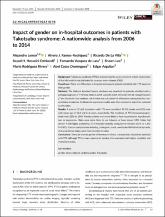Impact of gender on in‐hospital outcomes in patients with Takotsubo syndrome: A nationwide analysis from 2006 to 2014

View/
Trabajo
(application/pdf: 820.3Kb)
(application/pdf: 820.3Kb)
Date
2019-01-23Author(s)
Lemor, Alejandro
Ramos‐Rodriguez, Alvaro J.
De La Villa, Ricardo
Hosseini Dehkordi, Seyed H.
Vazquez de Lara, Fernando
Lee, Shawn
Rodriguez Rivera, Mario
Casso Dominguez, Abel
Argulian, Edgar
Metadata
Show full item recordAbstract
Background
Takotsubo syndrome (TTS) is characterized by acute, transient systolic dysfunction of the left ventricle not attributed to coronary artery disease (CAD).
Hypothesis
There are differences in hospital outcomes in patients admitted with TTS based on their gender.
Methods
The National Inpatient Sample database was searched for patients admitted with a principal diagnosis of TTS from 2006 to 2014 using the ICD9‐CM code 429.83. Using Pearson's χ 2 and Student's t test analyses, the P ‐value was calculated for differences among baseline characteristics of patients. Multivariate regression models were then created to adjust for potential confounders.
Results
A total of 39 662 admissions with TTS were identified, 91.7% female and 8.3% male with mean age of 66.5 and 61.6 years, respectively. The incidence of TTS increased progressively from 2006 to 2014. Female patients were more likely to have hypertension, hypothyroidism, or depression. Males were more likely to use tobacco, or have known CAD. Males had almost 4‐fold higher probability of in‐hospital mortality compared to females (3.7% vs 1.1%; P <0.001). Certain complications including cardiogenic shock, ventricular fibrillation/tachycardia, and acute kidney injury were more common in males.
Conclusions
There are distinct gender differences in clinical characteristics of patients admitted with TTS. Although TTS is more common in females, it is associated with higher morbidity and mortality in males.
Collections
- Artículos [274]
Publisher
John Wiley & Sons Ltd
Rights
info:eu-repo/semantics/openAccess







